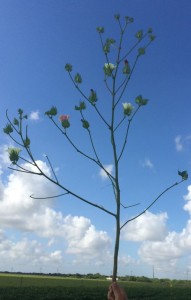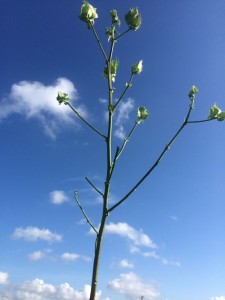 Cotton planted in March has been cutout for several weeks and the younger cotton, planted in May is around 5 Nodes Above White Flower (NAWF).
Cotton planted in March has been cutout for several weeks and the younger cotton, planted in May is around 5 Nodes Above White Flower (NAWF).
We are finding evidence of stink bug feeding in fields where we are able to find 1-inch bolls. In these fields it is important to note when the field reaches 5 NAWF. Cotton fields are considered safe from most insect pests, including stink bugs, once the field is 350 heat units (HU) beyond 5 NAWF.
A Heat Unit is calculated by averaging the high and low temperature for each day and subtracting 60. For example, yesterday, a weather station near Victoria recorded high and low temperatures of 95 and 74. To calculate the heat units accumulated yesterday, divide the sum of 95 and 74 by 2 and subtract 60.
(95 + 74) / 2 – 60 = 24.5 Heat Units
Fruit Loss
There is not a lot of optimism in some of the cotton fields because of problems with fruit retention. While we are accustomed to 10-15 bolls per plant at cutout, we are finding more fields with 3-5 bolls per plant. Some fields planted before the spring rains seem to have a hole in the crop. Plants may have 20+ nodes but are missing much of the fruit on nodes 8-14.
Cotton fields planted in May, after the spring rains, have lost much of the bottom crop. I am finding plants with 15-17 nodes having few first position fruit below the 13th node.

 The plants in these pictures are representative plants from different fields near Port Lavaca. They have 17 and 20 nodes but the oldest bolls are only 3-4 days old.
The plants in these pictures are representative plants from different fields near Port Lavaca. They have 17 and 20 nodes but the oldest bolls are only 3-4 days old.
While many of these fields had economic populations of cotton fleahopper earlier in the season, they were treated properly and most of the fruit losses occurred due to the wet and cloudy weather in May and June. I have been in fields that were treated for fleahoppers 2-5 times and don’t see much difference in fruit set.
In addition to a reduced ability for these fields to have yields resulting in farm profit, the lack of fruit creates many problems for insect management. A plant with 17 nodes should have sufficient fruit on the plant such that cotton fleahoppers are no longer able to reduce yield or delay harvest.
It is not easy to scout for stink bugs when there are few bolls to be found. The best method to scout for stink bugs is by looking for evidence of feeding inside 1-inch bolls, which can be hard to find this year. You may want to take a drop cloth.
Harvest Expectations
In more normal years, cotton harvest in the Mid-Coast begins in August. Many of our cotton fields won’t be harvested until mid-September or later. This brings the risk of fall rains.
We expect the time from white bloom to open boll to take 50-60 days or about 1100 heat units. (Cotton Growth and Development Publication) Fruit that bloomed today will be harvestable towards the end of September. Fields with few bolls below today’s white bloom will likely be open for harvest in mid to late October.